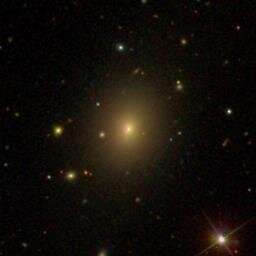January 30, 2020 report
Astronomers investigate broadband variability of the blazar Markarian 501

An international team of astronomers has studied variable broadband emission of the gamma-ray blazar Markarian 501 during a period of its high X-ray activity. The research, published January 21 on the arXiv preprint server, could lend better understanding of emission mechanisms in blazars.
Blazars are very compact quasars associated with supermassive black holes at the centers of active, giant elliptical galaxies. They belong to a larger group of active galaxies that host active galactic nuclei (AGN), and their characteristic features are relativistic jets pointed almost exactly toward the Earth. Based on their optical emission properties, astronomers divide blazars into two classes: flat-spectrum radio quasars (FSRQs) that feature prominent and broad optical emission lines, and BL Lacertae objects (BL Lacs), which do not.
Located some 456 million light years away, Markarian 501 (or Mrk 501 for short), is a well-known gamma-ray blazar. It belongs to BL Lacertae objects, and its optical spectra are dominated by the non-thermal continuum from the jet.
Observations of Mrk 501 conducted in 1996 using the Whipple Observatory have shown that it emits very high-energy (VHE) gamma-rays (over 100 GeV). So far, it is one of only few VHE objects detectable with currently available telescopes in relatively short time, even during low-state emission periods. This makes Mrk 501 an excellent target for long-term multi-wavelength monitoring.
So a group of astronomers led by Josefa Becerra Gonzalez of University of La Laguna, Spain, performed an extensive multi-instrument observational campaign to characterize and study the temporal evolution of the broadband emission of Mrk 501, focusing on July 2014, when the source exhibited very high X-ray activity. For this purpose, they employed various space telescopes and ground-based observatories, including the Major Atmospheric Gamma Imaging Cherenkov Telescopes (MAGIC), First G-APD Cherenkov Telescope (FACT), Fermi Gamma-ray Space Telescope and the Neil Gehrels Swift Gamma-ray Burst Observatory.
"We presented observational and theoretical results derived with multi-instrument data from Mrk 501 collected during a two-week period in July 2014, when the X-ray activity was at its highest among the 14 years of operation of the Neil Gehrels Swift Gamma-ray Burst Observatory," the astronomers wrote in the paper.
In general, the VHE emission from Mrk 501 was found to be elevated during the X-ray outburst of July 2014, with a gamma-ray flux above 0.15 TeV. During this two-week period, the flux variations in the radio, optical, and GeV bands were found to be mild, but quite substantial in the X-ray bands, and especially substantial in the VHE bands (the VHE variability was identified to be twice as large as the X-ray variability).
A detailed study of the temporal evolution of the broadband spectral energy distribution (SED) during the outburst period has been performed. The results show that the daily evolution of X-ray and gamma-ray bands could be well described with a one-zone synchrotron self-Compton (SSC) model with variations in the break energy of the electron energy distribution (EED), and with some adjustments in the magnetic field strength and spectral shape of the EED.
Taking these results into account, the astronomers concluded that the variations in the broadband emission of the studied blazar may be due to changes in the acceleration and cooling of the electrons in the shock in jet model.
Moreover, a narrow feature was identified at about 3.0 TeV in the VHE gamma-ray spectrum from the MAGIC telescopes. The authors of the paper presented some scenarios that may explain the nature of this feature, however further studies are needed to confirm which one is the most plausible.
"We investigated three theoretical scenarios that could reproduce it: a) pileup in the electron energy distribution due to stochastic acceleration; b) a structured jet with two-SSC emitting regions (related or not related), with one region dominated by an extremely narrow electron energy distribution; and c) an emission produced via an IC [inverse Compton] pair cascade induced by electrons accelerated in a magnetospheric vacuum gap, in addition to the SSC emission from a more conventional region along the jet of Mrk 501," the researchers concluded.
More information: Study of the variable broadband emission of Markarian 501 during the most extreme Swift X-ray activity, arXiv:2001.07729 [astro-ph.HE] arxiv.org/abs/2001.07729
© 2020 Science X Network




















